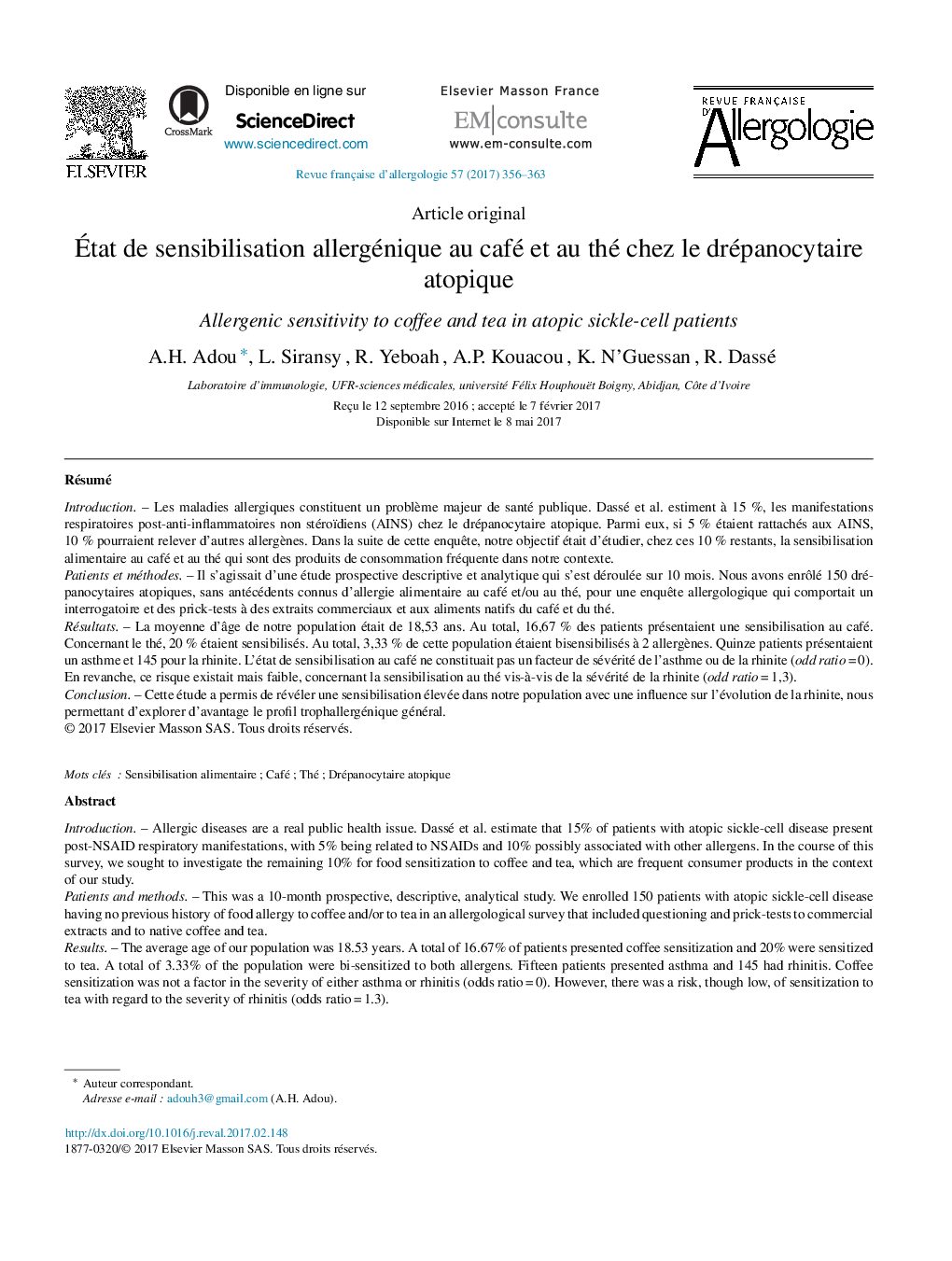| کد مقاله | کد نشریه | سال انتشار | مقاله انگلیسی | نسخه تمام متن |
|---|---|---|---|---|
| 5669869 | 1407983 | 2017 | 8 صفحه PDF | دانلود رایگان |

RésuméIntroductionLes maladies allergiques constituent un problème majeur de santé publique. Dassé et al. estiment à 15 %, les manifestations respiratoires post-anti-inflammatoires non stéroïdiens (AINS) chez le drépanocytaire atopique. Parmi eux, si 5 % étaient rattachés aux AINS, 10 % pourraient relever d'autres allergènes. Dans la suite de cette enquête, notre objectif était d'étudier, chez ces 10 % restants, la sensibilisation alimentaire au café et au thé qui sont des produits de consommation fréquente dans notre contexte.Patients et méthodesIl s'agissait d'une étude prospective descriptive et analytique qui s'est déroulée sur 10 mois. Nous avons enrôlé 150 drépanocytaires atopiques, sans antécédents connus d'allergie alimentaire au café et/ou au thé, pour une enquête allergologique qui comportait un interrogatoire et des prick-tests à des extraits commerciaux et aux aliments natifs du café et du thé.RésultatsLa moyenne d'âge de notre population était de 18,53 ans. Au total, 16,67 % des patients présentaient une sensibilisation au café. Concernant le thé, 20 % étaient sensibilisés. Au total, 3,33 % de cette population étaient bisensibilisés à 2 allergènes. Quinze patients présentaient un asthme et 145 pour la rhinite. L'état de sensibilisation au café ne constituait pas un facteur de sévérité de l'asthme ou de la rhinite (odd ratio = 0). En revanche, ce risque existait mais faible, concernant la sensibilisation au thé vis-à -vis de la sévérité de la rhinite (odd ratio = 1,3).ConclusionCette étude a permis de révéler une sensibilisation élevée dans notre population avec une influence sur l'évolution de la rhinite, nous permettant d'explorer d'avantage le profil trophallergénique général.
IntroductionAllergic diseases are a real public health issue. Dassé et al. estimate that 15% of patients with atopic sickle-cell disease present post-NSAID respiratory manifestations, with 5% being related to NSAIDs and 10% possibly associated with other allergens. In the course of this survey, we sought to investigate the remaining 10% for food sensitization to coffee and tea, which are frequent consumer products in the context of our study.Patients and methodsThis was a 10-month prospective, descriptive, analytical study. We enrolled 150 patients with atopic sickle-cell disease having no previous history of food allergy to coffee and/or to tea in an allergological survey that included questioning and prick-tests to commercial extracts and to native coffee and tea.ResultsThe average age of our population was 18.53 years. A total of 16.67% of patients presented coffee sensitization and 20% were sensitized to tea. A total of 3.33% of the population were bi-sensitized to both allergens. Fifteen patients presented asthma and 145 had rhinitis. Coffee sensitization was not a factor in the severity of either asthma or rhinitis (odds ratio = 0). However, there was a risk, though low, of sensitization to tea with regard to the severity of rhinitis (odds ratio = 1.3).ConclusionThis study revealed high sensitization affecting the course of rhinitis in our population, allowing us to further investigate the general trophallergenic profile.
Journal: Revue Française d'Allergologie - Volume 57, Issue 5, September 2017, Pages 356-363